|
|
Why peace has a foothold in the Philippines
an article by Angela Lederach, Christian Science Monitor (partial, reprinted by permission)
I’ve recently returned from six months in the Philippines, where another milestone has been passed in peace talks between the government and an armed rebel group, the Moro Islamic Liberation Front (MILF). The milestones are starting to add up, and the destination of peace is finally – after decades of war – coming into view, offering hope to Filipinos and, perhaps, other conflict zones in the world.

The Hall of Peace of the Talaandig Tribe (Philippines). From Angela Lederach's blog
click on photo to enlarge
The Philippine conflict is centered in Mindanao, the southern island, where the MILF and the government have battled each other year after year. Clan warfare plays a role, and so, too, does a sense of injustice among the island's Muslims toward the country's dominant Christian population.
Perhaps the war’s most devastating mark has been the culture of fear that pervades this Pacific archipelago of 92 million people. Those in the north tend to lump all of Mindanao into one large, terrifying hotbed of armed conflict. The fear also pervades Mindanao – including places that are relatively removed from violent clashes. At any moment, violence could erupt, a bomb could go off, and a place called home could be engulfed in flame.
In April, however, the Philippines government and MILF took a giant step toward peace, agreeing on ways to create an autonomous political entity in the southern region of Mindanao. The agreement demonstrates the earnestness of the two parties to come to a negotiated settlement. A radical fringe group has tried to thwart the peace efforts, but has not succeeded.
In my work as a conflict-resolution specialist on Mindanao, I also met dozens of local “peace practitioners” whose commitment is crucial to a successful outcome of the peace process. Many of them are directly affected by the war. They willingly enter the most violent areas, providing relief in the midst and aftermath of violent clashes, help in healing trauma, temporary shelter for displaced people, and grassroots training in nonviolence. Theirs is a holistic approach to creating a culture of peace in Mindanao – from elementary schools to politicians.
The commitment is paying off. A recent report found that a cease-fire is holding. In the first six months of this year, there were zero armed clashes between the MILF and the Philippines government. . .
What makes the potential for sustainable peace a real possibility in the Philippines are the steps being made simultaneously by high-level leaders and grass-roots organizations . . .
[Editor's Note: Click here to go to the full article in the Christian Science Monitor, or here to go to Angela Lederach's blog on which it is based.]
|








|
DISCUSSION
Question(s) related to this article:
What is the latest update on the peace situation in Mindanao?,
* * * * *
LATEST READER COMMENT:
The agreement of October 15 2012 has given rise to optimism, but many problems remain. For a typical analysis see that of The Economist.
The Philippines' Southern Insurgency
It could be peace
Hopes grow for an end to a bloody and long-running insurgency
AFTER 16 years of on-and-off negotiations, the Philippines government and the main Muslim rebel group in the southern region of Mindanao, the Moro Islamic Liberation Front, agreed to the outlines of a peace deal on October 6th. The two sides are due to sign it formally on October 15th. If it works, which is far from guaranteed, it could bring an end to more than four decades of fighting by armed Muslims seeking independence from the mainly Christian archipelago nation. The Mindanao conflict has killed perhaps 120,000 people and displaced 2m more. Mindanao is home to most of the country’s Muslims, who make up about 5% of the population of about 100m.
The agreement is not a final peace deal, but rather what President Benigno Aquino describes as “a framework agreement” and the front calls a “road map”. Yet both sides believe that it paves the way for what Mr Aquino hopes will prove “a final, enduring peace” in Mindanao.
The peace plan envisages the establishment of an autonomous Muslim area in Mindanao, called Bangsamoro, subject to a plebiscite there. The proposed Bangsamoro will have budgetary autonomy and a just share of revenues from the extraction of southern resources; its own police force; and sharia law for Muslims only. . ...more.

|
|









